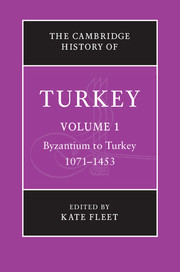Book contents
- Frontmatter
- 1 Introduction
- 2 The Byzantine Empire from the eleventh to the fifteenth century
- 3 Anatolia under the Mongols
- 4 Anatolia, 1300–1451
- 5 The incorporation of the Balkans into the Ottoman Empire, 1353–1453
- 6 Ottoman warfare, 1300–1453
- 7 The Turkish economy, 1071–1453
- 8 Art and architecture, 1300–1453
- 9 Social, cultural and intellectual life, 1071–1453
- Glossary
- Bibliography
- Index
- References
5 - The incorporation of the Balkans into the Ottoman Empire, 1353–1453
Published online by Cambridge University Press: 28 March 2010
- Frontmatter
- 1 Introduction
- 2 The Byzantine Empire from the eleventh to the fifteenth century
- 3 Anatolia under the Mongols
- 4 Anatolia, 1300–1451
- 5 The incorporation of the Balkans into the Ottoman Empire, 1353–1453
- 6 Ottoman warfare, 1300–1453
- 7 The Turkish economy, 1071–1453
- 8 Art and architecture, 1300–1453
- 9 Social, cultural and intellectual life, 1071–1453
- Glossary
- Bibliography
- Index
- References
Summary
In the existing historiography of the Balkans the Turks are usually represented as thosewho came last and consequently, when the national states were set up, had to go first. It is therefore important to realise that the contacts between the various Turkic peoples and the Balkans are at least as old as the settlement of the Slavs (sixth-seventh century) or even older. On the following pages the pieces of scattered information at our disposal concerning these groups will be pieced together.
The Szekler, a group of more than half a million people living in the eastern part of Transylvania, trace their origin straight to Attila and his Huns. Kutrigurs and Onogurs (the latter giving their name to the country of Hungary/Ungarn) are evidently of Turkish, or, better, Turkic origin. It was in the sixth century, under the leadership of the Turco-Mongolian Avars, that the Slavs invaded and settled the central and southern Balkans, and pushed on as far as the southern tip of the Peloponnese. The Avars were finally subjugated by Charlemagne and those who were left were assimilated. The Slavs remained. A rather similar fate was met by the Bulgars, a nomadic Turkic people moving in from the Eurasian steppes and, under their hans, setting up a powerful pagan empire (681).
- Type
- Chapter
- Information
- The Cambridge History of Turkey , pp. 138 - 191Publisher: Cambridge University PressPrint publication year: 2009
References
- 5
- Cited by



